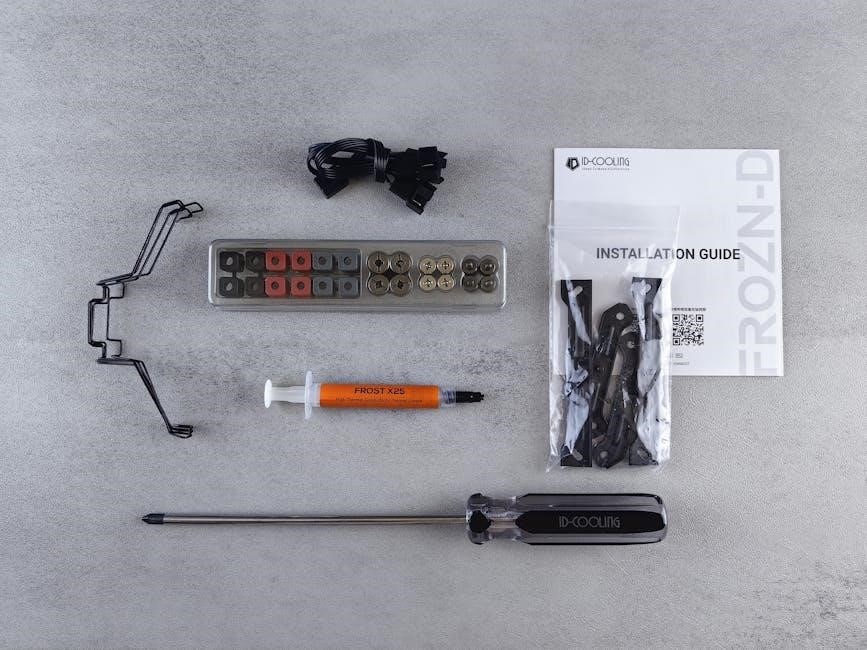Hayward Super Pump installation guide provides essential information for proper installation, ensuring safe and efficient operation of the pump, with detailed instructions and guidelines for a successful setup, using correct procedures and materials always.
Importance of Proper Installation
The importance of proper installation of the Hayward Super Pump cannot be overstated, as it plays a crucial role in ensuring the safe and efficient operation of the pump. A correct installation will help to prevent accidents, reduce the risk of electrical shock, and minimize the likelihood of damage to the pump and surrounding equipment. Furthermore, a proper installation will also help to optimize the performance of the pump, reducing energy consumption and extending its lifespan. The manufacturer’s instructions should be followed carefully, and any necessary safety precautions should be taken to ensure a successful installation. By prioritizing proper installation, pool owners can enjoy a safe and reliable pumping system, and minimize the need for costly repairs and maintenance. The installation process requires attention to detail, and a thorough understanding of the pump’s components and operating principles. Proper installation is essential for a trouble-free operation of the Hayward Super Pump.
Overview of Hayward Super Pump Series
The Hayward Super Pump Series is a range of high-performance pumps designed for swimming pool applications, offering a combination of efficiency, reliability, and durability. The series includes various models, each with its own unique features and specifications, to cater to different pool sizes and types. With over 100 years of experience in the industry, Hayward has developed a reputation for producing high-quality equipment that meets the needs of pool owners. The Super Pump Series is designed to provide superior performance, with advanced technologies and innovative designs that minimize energy consumption and reduce noise levels. The pumps are also built with corrosion-resistant materials and robust construction, ensuring a long lifespan and minimal maintenance requirements. The Hayward Super Pump Series is a popular choice among pool owners, offering a reliable and efficient solution for their pumping needs, and is widely available through authorized dealers and online retailers. The series is backed by comprehensive support and resources, including installation guides and troubleshooting manuals.

Pre-Installation Considerations
Consider factors like space, electrical supply, and plumbing connections before installing Hayward Super Pump, using proper planning and preparation always.
Understanding the Pump’s Components
To ensure a successful installation, it is crucial to understand the various components of the Hayward Super Pump, including the motor, impeller, and shaft seals. The motor is the heart of the pump, providing the power needed to circulate water throughout the pool system. The impeller is responsible for creating the flow of water, while the shaft seals prevent leaks and ensure a tight seal around the shaft. Additionally, the pump also includes other components such as the seal plates, gaskets, and O-rings, which play important roles in maintaining the pump’s efficiency and performance. By familiarizing yourself with these components, you can better understand how the pump works and identify potential issues that may arise during installation. This knowledge will also help you to properly install and maintain the pump, ensuring optimal performance and longevity. Proper installation is key to a safe and efficient operation.
Grounding and Bonding Requirements
Proper grounding and bonding are essential for the safe and efficient operation of the Hayward Super Pump. The pump’s electrical components must be grounded to prevent electrical shock and ensure safe operation. The grounding system should be connected to a suitable grounding point, such as a copper water pipe or a grounding rod, to provide a safe path to ground for electrical currents. Additionally, the pump’s metal components must be bonded together to prevent voltage differences and ensure electrical continuity. The bonding system should be designed to provide a reliable and durable connection between the pump’s metal components, and should be installed in accordance with local electrical codes and regulations. By following the recommended grounding and bonding procedures, you can ensure a safe and reliable installation of the Hayward Super Pump, and prevent potential electrical hazards. The installation should be done by a qualified electrician to ensure compliance with safety standards.

Installation Procedures
Follow the step-by-step guide for a successful Hayward Super Pump installation, ensuring all connections are secure and proper procedures are used always.
Connecting the Wires and Electrical Connections

To ensure a safe and efficient installation, it is crucial to connect the wires and electrical connections correctly, following the manufacturer’s instructions and guidelines. The Hayward Super Pump installation guide provides detailed information on the wiring diagram and electrical connections, including the grounding and bonding requirements. It is essential to consult the manual and understand the wiring configuration before attempting to connect the wires. The pump’s electrical connections should be made in accordance with the local electrical codes and regulations, and it is recommended to consult a licensed electrician if you are unsure about any aspect of the installation. By following the correct procedures and using the right materials, you can ensure a successful and safe installation of your Hayward Super Pump. The electrical connections should be secure and protected from damage, and the pump should be installed in a well-ventilated area, away from any flammable materials.
Installing the Shaft Seals and Pump Seal Plates
The installation of the shaft seals and pump seal plates is a critical step in the Hayward Super Pump installation process. According to the manufacturer’s instructions, it is essential to use the correct shaft seal for the specific motor and pump configuration. The seal plates should be installed in the correct orientation, with the new seal halves facing each other correctly. The Hayward Super Pump series uses different shaft seals depending on the motor, so it is crucial to select the right one to ensure proper function and prevent leaks. The installation process requires careful attention to detail, and it is recommended to consult the manual and follow the instructions carefully to avoid any mistakes. By installing the shaft seals and pump seal plates correctly, you can ensure a leak-free and efficient operation of your Hayward Super Pump, and enjoy a long-lasting and trouble-free performance. The correct installation of these components is vital to the overall performance and longevity of the pump.

Post-Installation Checks and Tests
Verify pump operation, check for leaks, and test performance, ensuring a safe and efficient Hayward Super Pump installation, using correct procedures always, with detailed guidelines and instructions available online.
Verifying the Pump’s Operation and Performance
To verify the pump’s operation and performance, it is essential to follow the manufacturer’s instructions and guidelines. The Hayward Super Pump installation guide provides detailed information on how to test the pump’s operation, including checking for leaks, verifying the pump’s pressure and flow rate, and ensuring that the pump is operating within the recommended parameters. The guide also provides troubleshooting tips and procedures to help resolve any issues that may arise during the testing process. By following these guidelines and procedures, pool owners can ensure that their Hayward Super Pump is installed and operating correctly, providing safe and efficient pool operation. The pump’s performance can be verified by checking the pump’s motor, impeller, and other components to ensure they are functioning correctly. Additionally, the guide provides information on how to monitor the pump’s performance over time, including how to check for signs of wear and tear, and how to perform routine maintenance tasks.
Troubleshooting Common Issues and Concerns
Troubleshooting common issues and concerns is an essential part of the Hayward Super Pump installation guide. The guide provides a comprehensive list of potential issues that may arise during the installation and operation of the pump, along with step-by-step instructions on how to resolve them. Some common issues include leaks, low pressure, and motor failure. The guide also provides information on how to diagnose and repair these issues, including how to check for blockages, inspect the pump’s components, and replace worn or damaged parts. By following the troubleshooting guide, pool owners can quickly and easily resolve common issues and concerns, minimizing downtime and ensuring that their pool is always safe and functional. The guide also provides information on how to prevent issues from arising in the future, including how to perform routine maintenance tasks and how to inspect the pump’s components regularly. Regular maintenance can help extend the life of the pump.
